This week, I start to delve into the specific denominations of the second Waterlow issue of the Niger Coast Protectorate, with the halfpenny green. This week's post will look at the shade variations, paper and gum varieties, cancellations and plate flaws.
Shade Variations
This stamp exists in a wide variety of shades that progress from bright yellow green, to deeper yellow green, deep bright green, deep green and myrtle green. Ince states that the first printings are yellow green, and that the progression was to deep green and then sage greens. However, from the dates I have seen on cancelled examples, it appears that there was not a straightforward progression of shades, but rather many of the shades were produced concurrently. Gibbons only lists this stamp in the yellow green and deep green shades. However, as we shall see this is an over-simplification.
In illustrating and describing the shades I will use the Gibbons colour key, as always.
Group 1: The Yellow Green Shades
The green shades of this stamp all vary depending on the balance between the yellow, green and blue in the mix. The yellow green shades all appear bright by comparison to the other shades of green, and yellow dominates in the colour mix. Within this group, I have found variations in brightness and intensity. Below are some examples of these shades:
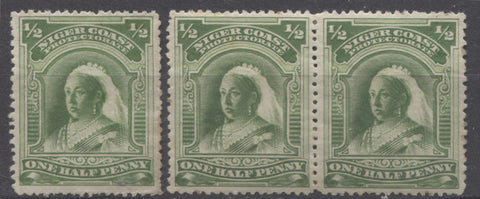
Here we have what Gibbons refers to as the basic yellow green. The stamp on the left being just a touch brighter than the stamps in the pair. On the Gibbons colour key this is actually closest to bright green, but is deeper.
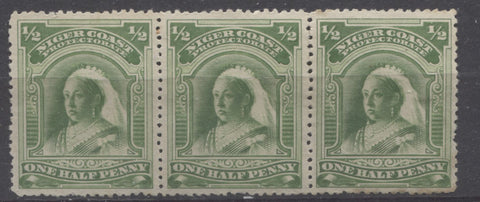
This strip is both slightly lighter, and brighter than the stamps above. It is close to the Gibbons bright green, but is a bit deeper. It is a paler version of the yellowish green.
Group 2: The Deep Yellow Green and Sage Green Shades
In this group the shades a deep and rich, with yellow dominating in some of the shades, while in others the yellow and blue are in almost perfect balance. Below are some of these shades:

The stamp on the left is a deeper version of Gibbons's yellowish green. The stamp on the right is the same intensity, but the green contains a hint of olive. However, it is nowhere close to any of the actual olive, or olive green shades on the Gibbons colour key.

This pair is a perfect match to Gibbons yellowish green.
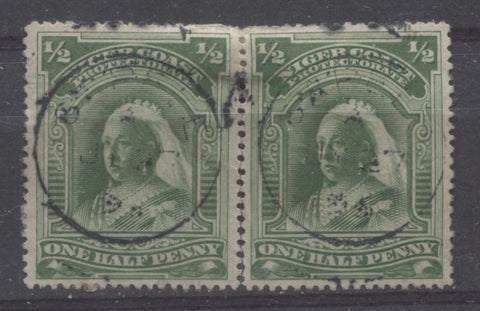
This pair is a slightly duller version of the yellowish green.
Group 3: The Deep Green Shades
In this group, the colour no longer appears bright, but is deep, with more green and much less yellow.
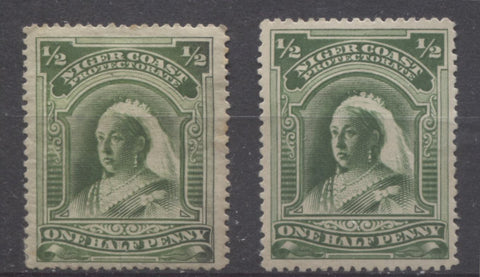
These two stamps are very deep versions of Gibbons' yellowish green. They are not quite dull enough to be the deep green. The stamp on the left contains a hint of olive to the green, though again not enough to make it a match with any of the olive green shades.

The stamp on the left is a perfect match to to Gibbons' deep dull green. The middle two stamps are an almost perfect match to Gibbons' deep green. The stamp on the right is brighter, being a deep bright yellowish green.
Group 4: The Myrtle Green Shades
The next group of shades is the myrtle green group. Myrtle green is a cross between deep green and blue green. The stamps definitely appear bluish compared to the other shades. However, they are not blue enough to be blue green.
 These stamps appear bluish in comparison to the other shades. The stamp on the left, and the stamp on the right are closest to Gibbons' myrtle green, but are a little brighter. The pair in the middle is an almost perfect match to the basic green shade on the Gibbons colour key.
These stamps appear bluish in comparison to the other shades. The stamp on the left, and the stamp on the right are closest to Gibbons' myrtle green, but are a little brighter. The pair in the middle is an almost perfect match to the basic green shade on the Gibbons colour key.
Paper and Gum Types
In studying these stamps, I have come across what appear to be four distinct types of paper and three different types of gum. Certain types of gum appear to be confined to specific paper types, while some paper types can have both types of gum. So, in total I have found 7 different paper and gum combinations.
The types of paper and gum can best be described as follows:
- A thin, white horizontal wove paper with a relatively fine mesh pattern and a colourless gum that has a satin sheen. This seems to be found mainly on the first printings, which are primarily found in the yellow green shades.
- Medium white vertical wove paper, with a relatively fine mesh pattern, and a colourless gum that has a satin sheen.
- A slightly yellowish vertical wove paper, with a relatively fine mesh pattern and a colourless gum that has a semi-gloss sheen.
- A thin, translucent, vertical wove paper that is slightly greyish in colour and has a fine mesh pattern. I do not have a mint example, so I cannot say for certain which gum type is found on this paper, but I suspect it is the poor gum that Ince and Osborne refer to in their work.
- A medium white horizontal wove paper with coarser mesh and clear gum that has a satin sheen. This is found on the deeper yellow green and emerald green shades.
- A transparent, medium vertical wove paper with coarse mesh and colourless gum that has a semi-gloss sheen. So far, I have only found this on the printings in deep green.
- A greyish horizontal wove paper that has an oily appearance. This paper has a thicker colourless gum which has a very glossy sheen.
The seventh type of paper and gum is very distinct. I have a mint block of 10 to which a piece of the interleaving paper that was sent with the shipments is almost completely stuck. It would appear that this is the paper that Ince refers to as having the poor gum in terms of adhesion. I had assumed up to this point that what Ince meant was that the gum did not adhere well. But it appears that he may have meant the opposite - that it was so sensitive to moisture that the stamps stuck to the interleaving paper that came with the shipments.
The paper and gum types are all illustrated below:

Here is the first type: the horizontal wove paper, with fine mesh and clear, satin sheen gum.
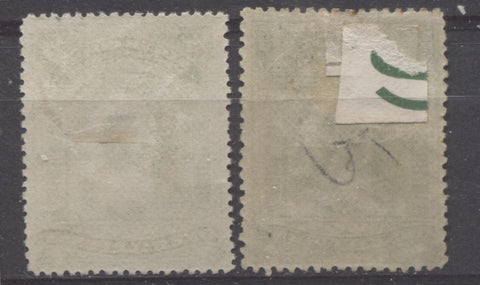
On the left we have paper and gum type 2, and on the right, type 3.
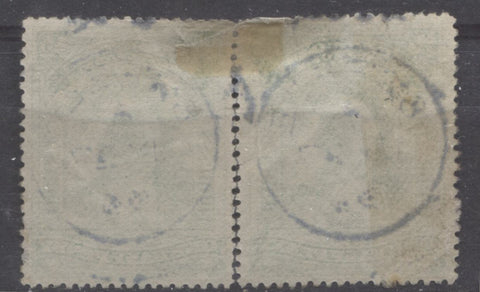
Paper type 4.
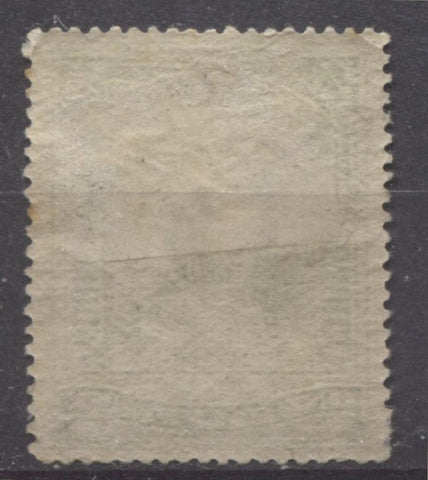
This is paper and gum type 5. Note how much more visible the mesh is. Here are some more examples:

The difference between this type is subtle, but at the same time quite obvious, once you know what to look for.
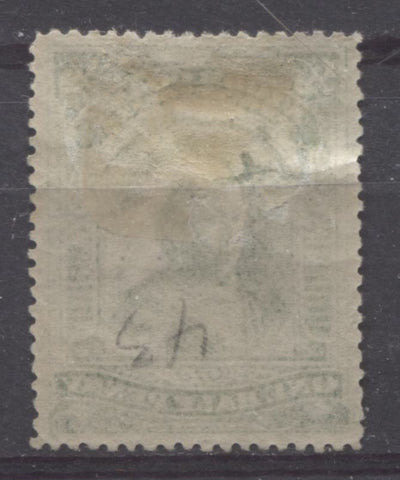
Here is paper and gum type 6. Note how you can see most of the design throught the back and how coarse the appearance of the mesh is.
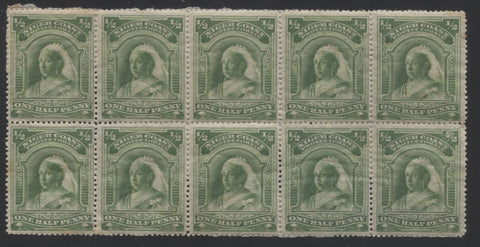
Plate Flaws and Re-entries
Ince and Osborne only list two plate flaws on this stamp, which occur on positions 53 and 60 of the sheet:
- On position 53, the fraction bar of the right hand 1/2 has a double stroke. I believe this is a re-entry that affects several of the letters in Coast and Protectorate as well.
- On position 60, the right hand fraction has dots in the stroke and in the figure "1". This is a re-entry also, that affects the "O" in Coast, as we shall see.
Starting with the position 53 re-entry, it comes in different strengths, but in all cases there are dashes within the fraction bar at right, and then doubling at the top of the "T" of "Coast" and "E" of "Protectorate" In addition, there are dots in the "O" of "Coast" and "ORA" of "Protectorate".
The high resolution scans show three examples of this re-entry:
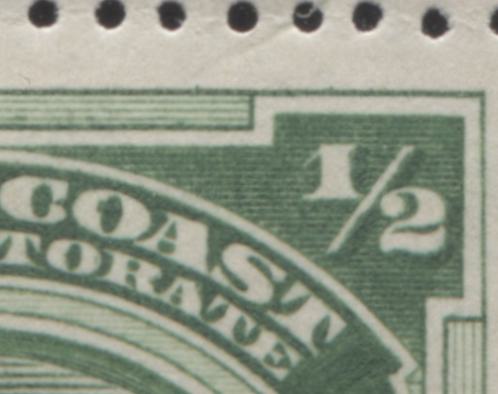
This is probably the least strong of the three. You can clearly see the extra colour inside the right fraction bar and the markings in both O's and the RA of Protectorate. There is doubling at the top of the "T" and "E", but it is very thin and hard to see.
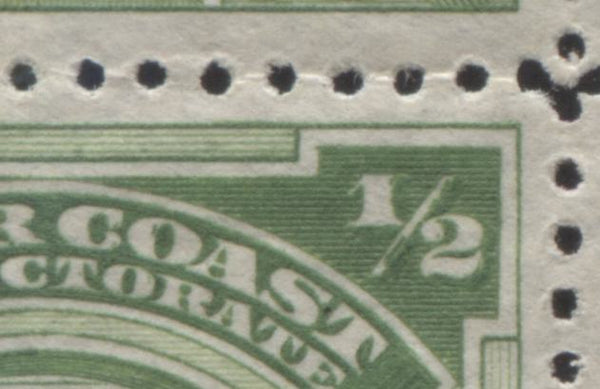
Here is a much stronger example that shows clear lines inside the fraction bar, but also doubling at the lower curl of the "2" and the top of the "1". Because of colour only the markings in the "O's are clear. But in reality all the doubling I spoke of earlier is present on this stamp.
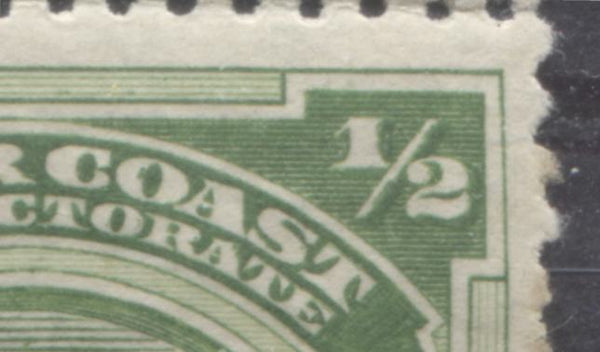
On this example if you look closely you can see the doubling at the top of the "T" of Coast, and the "E" of "Protectorate". It is visible as a thin line at the top of the letter.
The Position 60 re-entry is similar, but includes less lines inside the fraction bar, more dots, as well as dots inside the 1, and no markings or doubling inside any of the letters, except the "O" of "Coast". I have two examples, one on a myrtle green stamp and one on a yellow green:

Here, you can see the markings inside the fraction bar are just dashes and dots, and you can see two clear dots inside the "1". Note how the letters are all free of markings, except the "O" of "Coast".
Here is the second example with the yellow green stamp:

In addition to these two listed flaws, there are a few unlisted ones that I have found:
- A dash in the white frame under the "F" of "Half".
- A re-entry of the lower right outer frameline.
- A spur in the arch above "C" of "Coast".
These are shown in the following high resolution scans:

If you look carefully at this scan you can just make out the dash under the "F"
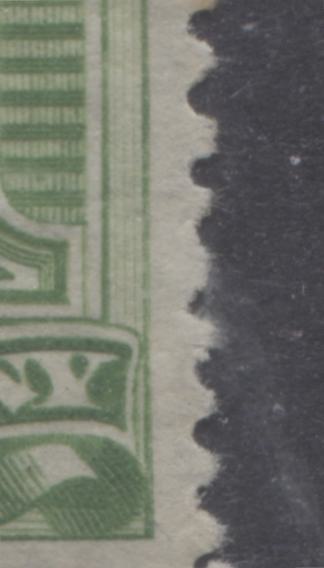
If you look at the lower right frameline you can clearly see doubling.
The next scan shows the spur above "C" of "Coast":
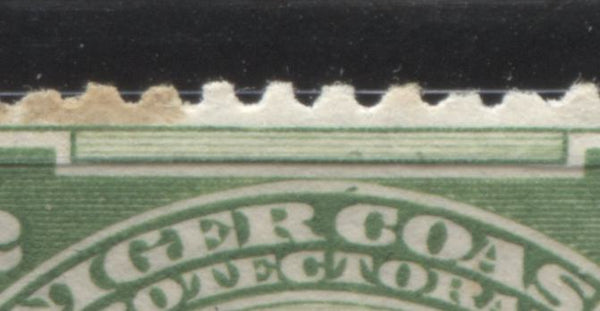
Cancellations
The usual range of villages is found on this stamp. However, I have not seen either Buguma or Sombriero River on this issue. Sapelle and Forcados River are two new locations that appear for the first time. In addition, I have seen variations in the Old Calabar River CDS in terms of the size of the letterings, which are new as well.
Benin River

These two pairs are cancelled with Proud type D2 CDS. The pair on the left having time code A, and the pair on the right having time code C.
Bonny River

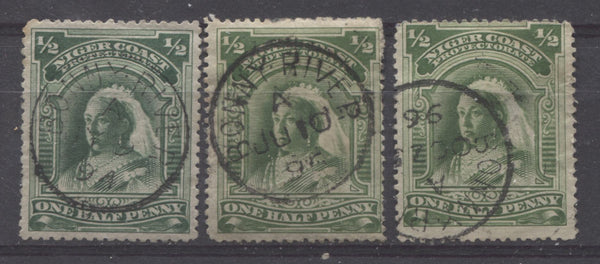
This is one of the more common village names, though not nearly as common as Old Calabar. These are all Proud type D2, with time code A.
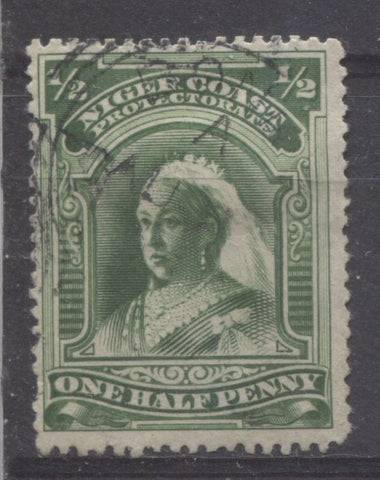
Here is a rather unclear example of a Proud D4 squared circle. also with time code A.
Brass River
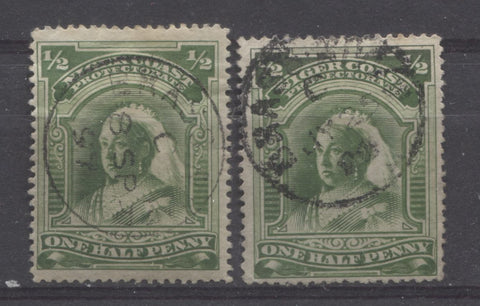
This is another one of the more common villages in the region. The above two stamps are cancelled with Proud type D2. In this case these both have time code C.
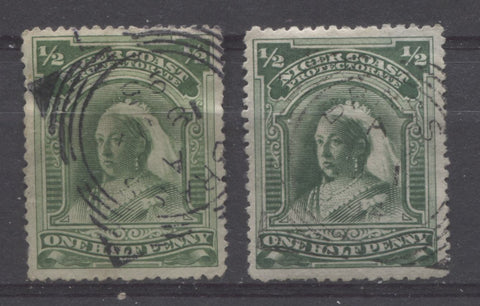
These are both examples of Proud type D4 with time code A.
Old Calabar River


By far, this is the most common post office during the period. These are the Proud type D2 CDS cancels that contain the full "Old Calabar River " inscription. However the top right stamp appears to be an anomaly. It looks a lot like Proud type D8, but with a dot between Old and Calabar, which does not appear on the illustration in Proud. Also type D8 was not known prior to October 30, 1898, and this one is clearly an 1894 date. These all appear to be time code A.
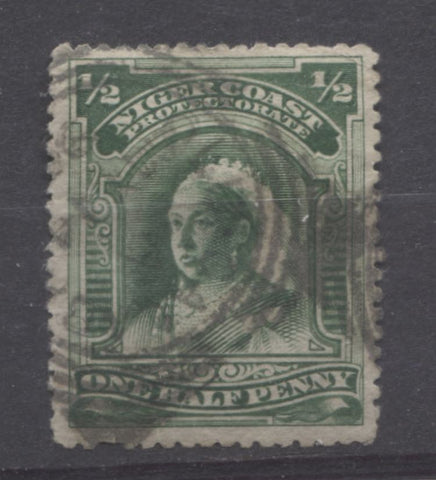
This is an example of the Proud type D4 squared circle.
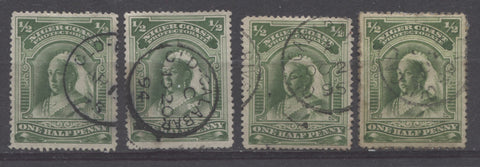
Here are four examples of the Old Calabar CDS cancel that replaced type D2 in early 1894.

Here are two examples of the Proud type R5 registered cancellation for Old Calabar River.
Sapelle
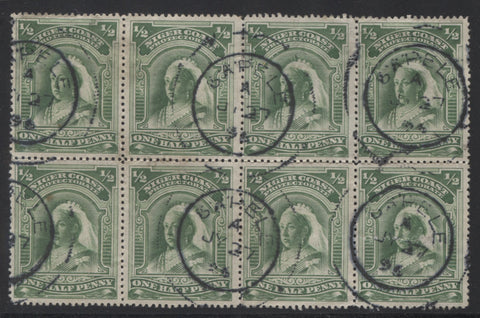
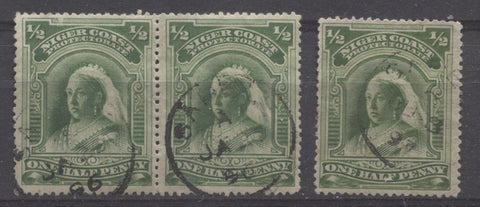
This is the scarcest of the cancellations so far. Both the block and the stamps below are cancelled with Proud type D2, with time code A.
Foreign Cancellations
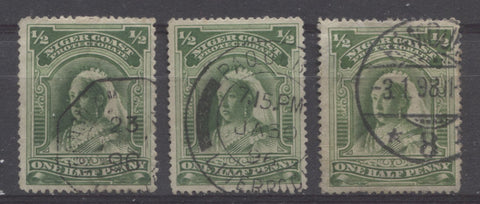
In addition to the Niger Coast cancellations, there are also a wide variety of foreign cancellations that can be found also. On the left, we have an octagonal Portuguese cancel. The middle stamp is struck with a Liverpool Paquebot cancel, while the stamp on the right is a German Hamburg CDS. Many of these are ship cancels that would have been applied to mail aboard ships that passed through the respective ports, or were applied on the ships themselves. For example the Hamburg cancel was likely from a Hamburg hammer that was aboard a German ship.
This concludes my post for this week. Next week I will look at the perforations of this stamp.


6 comments
Scorpions Lolitax Girls Fucked Assemblage
Pthc cp offline forum
https://apg.de/n1
apg.de/n1